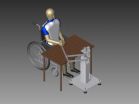(Press-News.org) This press release is available in German.
Catalytic converters work poorly if they have not yet warmed up. Tiny metal particles in a catalytic converter require a minimum temperature to function efficiently. At the Vienna University of Technology, thanks to a new measuring method, it has now become possible to examine many different types of these particles at the same time. Reliable information regarding what it is exactly that the efficiency of catalytic converters depends on has thus been obtained for the first time.
Low ignition temperature desired
"A large part of the pollutant emissions from an engine are generated immediately after start-up, while the catalytic converter is still cold", explains Prof. Günther Rupprechter from the Institute of Materials Chemistry at Vienna University of Technology. "Only when a certain temperature is exceeded does what is known as catalytic ignition occur and the catalytic converter functions with high efficiency." Complex and expensive catalytic converter heating systems have already been developed in order to reach this critical temperature as quickly as possible. It would, however, save both money and energy to build a catalytic converter that already functions well at the lowest possible temperatures.
Straight or slanting? It all depends on the angle
The critical temperature that the catalytic converter must reach depends on the material used: the precious metals platinum and palladium are used particularly often in catalytic converters. However, the crystallographic orientation of the surfaces of the tiny metal granules also plays an important role. Crystals can be cut in different highly-specific directions – this process is familiar from cut precious stones. Even the surfaces of naturally grown crystals are formed in differing directions and the orientation of these surfaces determines the chemical behaviour of the crystals. "It is apparent that surfaces with differing crystallographic directions require different temperatures for catalytic ignition", explains Prof. Yuri Suchorski, who works with Prof. Rupprechter.
Many measurements in one experiment
Previously, it had hardly been possible to investigate this effect in detail: a catalytic converter is made up of countless tiny granules. "Until now, it has only been possible to measure the superimposed activity of all these differently-oriented granules", says Rupprechter. However, Rupprechter and his team have now been able to use a photoemission electron microscope based on Einstein's famous "photo effect" to analyse the ignition temperatures of the individual metal granules whilst the reaction is occurring. For this, a film was used, on which many tiny crystals – with diameters of only around 100 micrometres – were arranged closely together. The directions of the crystals were randomly distributed, thereby allowing different crystal variants to be investigated in a single experiment.
Under the microscope, the temperature of the film was slowly increased, actually demonstrating that the catalytic ignition took place at different temperatures depending on the direction of orientation. "It is important to us to be able to investigate different crystal grains in close proximity and under identical conditions during a single experiment," explain the researchers. "If you carry out several experiments one after another, it is never possible to perfectly reproduce the external conditions so that the individual measurements are directly comparable."
With the new findings, it is now possible to perform targeted searches for manufacturing processes for catalytic converters with lower ignition temperatures. "We now know that palladium works better than platinum, and we know which crystallographic direction promises the lowest ignition temperature", says Günther Rupprechter. Now it should also be possible to implement these findings in technology, in order to build catalytic converters which take effect in cars as soon as possible after start-up.
###
For more information, please contact:
Prof. Günther Rupprechter
Institute of Materials Chemistry
Getreidemarkt 9, 1060 Vienna, Austria
Tel: +43 1 58801 165100
guenther.rupprechter@tuwien.ac.at
Catalytic converters like it hot
Vienna University of Technology has successfully clarified what it is the required operating temperatures of catalytic converters in cars depend on
2012-10-09
ELSE PRESS RELEASES FROM THIS DATE:
Digital tabletop system with views on demand
2012-10-09
A tabletop system where users can come together and view shared content will be unveiled today [Tuesday 9 October]. A team of scientists, led by the University of Bristol, have developed the system aimed at supporting mixed-focus collaborative tasks.
Researchers from the University's Department of Computer Science will present PiVOT (personalised view-overlays for tabletops) at the 25th ACM UIST 2012, a symposium for innovations in the software and technology of human-computer interfaces.
Through two view zones, PiVOT provides personalised views to individual users ...
Scientists develop a blood test that detects aggressive prostate cancers
2012-10-09
Scientists from the Spanish National Cancer Research Centre (CNIO) in Madrid, along with British colleagues from the Institute for Cancer Research (ICR) and the Royal Marsden NHS Foundation Trust, have developed a test that studies genetic patterns in blood cells to detect advanced–stage prostate cancer. The results of the study are being published today in the journal The Lancet Oncology.
The study shows that gene patterns in blood cells act as a barcode and could be used together with the current PSA test to select those patients with the worst prognosis in need of ...
Liquorice offers clue to cleaner medical implants
2012-10-09
Oxford, October 8, 2012 - A nanotech material containing an extract from liquorice can be used to sterilize and protect medical devices and implants which include biological components, and protects these functional bio-components during the sterilization process.
Publishing their findings in the latest issue of Materials Today, a team of researchers from Germany and Austria explain how conventional sterilization techniques based on a blast of radiation, or exposure to toxic gas can damage the functional biological components of the device. The coating, containing a component ...
New methods might drastically reduce the costs of investigating polluted sites
2012-10-09
This press release is available in German.Ferrara/Leipzig. New methods might allow polluted sites to be investigated and monitored long term at significantly reduced costs. Authorities and those who have to remediate polluted sites in Europe might therefore be able to save costs and use these to treat other areas. This is the conclusion of the EU research project ModelPROBE, which was coordinated by the UFZ. The results, with which the scientists aimed to lower the workload of authorities and consultants, include a handbook detailing the methods for characterising contaminated ...
Worldwide patent for a Spanish stroke rehabilitation robot
2012-10-09
VIDEO:
This is about the worldwide patent for a Spanish stroke rehabilitation robot.
Click here for more information.
Robotherapist 3D, a robot which aids stroke patients' recovery, is to be brought to market by its worldwide patent holder, a spin-off company from the Miguel Hernández University of Elche (Alicante, Spain). It is the first robot to enable patients to start doing exercises while supine, allowing them to begin shortly after the stroke and expediting recovery. ...
River Thames invaded with foreign species
2012-10-09
Almost 100 freshwater species not native to the UK have invaded the River Thames catchment making it one of the most highly invaded freshwater systems in the world, according to scientists at Queen Mary, University of London.
The research, published in the journal Biological Invasions at the weekend, suggests that legislation to prevent the introduction of non-native species across the UK has been unsuccessful. The cost to the British economy of invasive non-native species is £1.7bn every year (CABI report, 2010).
Lead author, Dr Michelle Jackson* who undertook the ...
VIB concludes that Séralini study is not substantiated
2012-10-09
The scientific analysis in this document shows that the research design of Séralini et al. contained fundamental shortcomings that preclude any sensible conclusions from being drawn. In other words, the statements that Séralini made about the health effects of GMOs and Roundup were baseless. Moreover, the research shows signs of selective interpretation of the findings or a misleading representation of these, which is contrary to prevailing scientific ethical standards.
###View the entire analysis online: http://www.vib.be/en/news/Pages/VIB-concludes-that-Seralini-study-is-not-substantiated-.aspx
...
A system to automate traffic fines is designed
2012-10-09
This press release is available in Spanish. The goal of the scientists in the Information and Communications Technology Security Group (Seguridad de las Tecnologías de la Información y las Comunicaciones - SeTI) at UC3M who are working on the E-SAVE project is to use information technologies (ITs) to improve the enforcement of certain traffic regulations. Specifically, they propose a set of systems for the automated, immediate and telematic supervision and management of the administrative sanctioning process. The purpose is to reduce highway accidents, given that one of ...
Researchers develop new way to determine amount of charge remaining in battery
2012-10-09
Researchers from North Carolina State University have developed a new technique that allows users to better determine the amount of charge remaining in a battery in real time. That's good news for electric vehicle drivers, since it gives them a better idea of when their car may run out of juice.
The research is also good news for battery developers. "This improved accuracy will also give us additional insight into the dynamics of the battery, which we can use to develop techniques that will lead to more efficient battery management," says Dr. Mo-Yuen Chow, a professor ...
UC research finds small signs lead to big frustrations
2012-10-09
Signs that are too small or unclear to consumers seem to be a growing national issue, leading some business owners to lose potential customers, according to University of Cincinnati Marketing Professor James Kellaris.
"This persistent, growing national problem is frustrating for consumers and can lead to loss of business and, by extension, loss of tax revenue for the community," Kellaris said.
Kellaris, the James S. Womack/Gemini Chair of Signage and Visual Marketing in the UC Carl H. Lindner College of Business, will present this research during the October 10 -11 ...
LAST 30 PRESS RELEASES:
Making lighter work of calculating fluid and heat flow
Normalizing blood sugar can halve heart attack risk
Lowering blood sugar cuts heart attack risk in people with prediabetes
Study links genetic variants to risk of blinding eye disease in premature infants
Non-opioid ‘pain sponge’ therapy halts cartilage degeneration and relieves chronic pain
AI can pick up cultural values by mimicking how kids learn
China’s ecological redlines offer fast track to 30 x 30 global conservation goal
Invisible indoor threats: emerging household contaminants and their growing risks to human health
Adding antibody treatment to chemo boosts outcomes for children with rare cancer
Germline pathogenic variants among women without a history of breast cancer
Tanning beds triple melanoma risk, potentially causing broad DNA damage
Unique bond identified as key to viral infection speed
Indoor tanning makes youthful skin much older on a genetic level
Mouse model sheds new light on the causes and potential solutions to human GI problems linked to muscular dystrophy
The Journal of Nuclear Medicine ahead-of-print tip sheet: December 12, 2025
Smarter tools for peering into the microscopic world
Applications open for funding to conduct research in the Kinsey Institute archives
Global measure underestimates the severity of food insecurity
Child survivors of critical illness are missing out on timely follow up care
Risk-based vs annual breast cancer screening / the WISDOM randomized clinical trial
University of Toronto launches Electric Vehicle Innovation Ontario to accelerate advanced EV technologies and build Canada’s innovation advantage
Early relapse predicts poor outcomes in aggressive blood cancer
American College of Lifestyle Medicine applauds two CMS models aligned with lifestyle medicine practice and reimbursement
Clinical trial finds cannabis use not a barrier to quitting nicotine vaping
Supplemental nutrition assistance program policies and food insecurity
Switching immune cells to “night mode” could limit damage after a heart attack, study suggests
URI-based Global RIghts Project report spotlights continued troubling trends in worldwide inhumane treatment
Neutrophils are less aggressive at night, explaining why nighttime heart attacks cause less damage than daytime events
Menopausal hormone therapy may not pose breast cancer risk for women with BRCA mutations
Mobile health tool may improve quality of life for adolescent and young adult breast cancer survivors
[Press-News.org] Catalytic converters like it hotVienna University of Technology has successfully clarified what it is the required operating temperatures of catalytic converters in cars depend on


